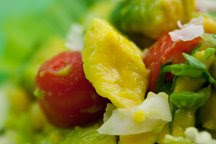Food safety is a big topic amongst the grocery chains, wholesalers and foodservice professionals. As well it should be.
Food safety is more than words. For the agricultural community it's a set of procedures that may have been ignored in the past, but it's getting harder and harder to ignore, and the future will only be more so. Produce buyers are driving the change. You have to farm right to sell what you grow.
Being in agriculture, food safety runs both sweet and sour; the priority is juxtaposed on how it can possibly be achieved. There are no easy cheap answers. And if you like inexpensive fresh fruits and vegetables, you don't want the expensive answers either.
Procedures are backed by documented proof that you did the procedures. It's the Sarbanes-Oxley of farming.
In a recent article in 'Fresh Cut' magazine, Dick Lehnert summed it up by saying
On the mundane level, it means no more letting your dog run about during harvest operations. Walk to the porta-potty - no more ducking behind a handy tree. Control things like problem wildlife. Know what to do if an employee on the packing line cuts his finger or sneezes on the product.
And you need to write it all down: write a manual spelling out the standard operating procedures on your farm or in your packing house, train your employees, document that they are following the manual, then hire "certifiers" to come onto your farm once a year to verify all of the above.
Unlike Sarbanes-Oxley, there's currently no legislation. It started in 2007 with the government putting together Good Agricultural Practices (GAPs) and Good Handling Practices (GHPs) and then demanding that food products it, the government buys for its nutrition programs be produced in conformity with these practices.
Leading produce buyers like Wal-Mart, Publix or say a Gerber Products started demanding the same from their suppliers. It's gathering momentum.
The company I work for is known for its premium tropical produce and was amongst the first wave of companies to be food safety certified. When we sell to customers that don't impose such requirements on their suppliers, it makes it hard to compete with other produce importers (most tropicals are grown outside the US). Produce is still very much a commodity market. The cost of achieving food safety certification is not cheap.
Yet the cost of not making food safety procedures standards is outbreaks of food borne illnesses that we've seen in organic spinach, tomatoes/peppers and peanut butter.
It's the old adage, nothing worth doing is easy to do.
 Recipe courtesy of Vegetarian Times Magazine
Recipe courtesy of Vegetarian Times Magazine















